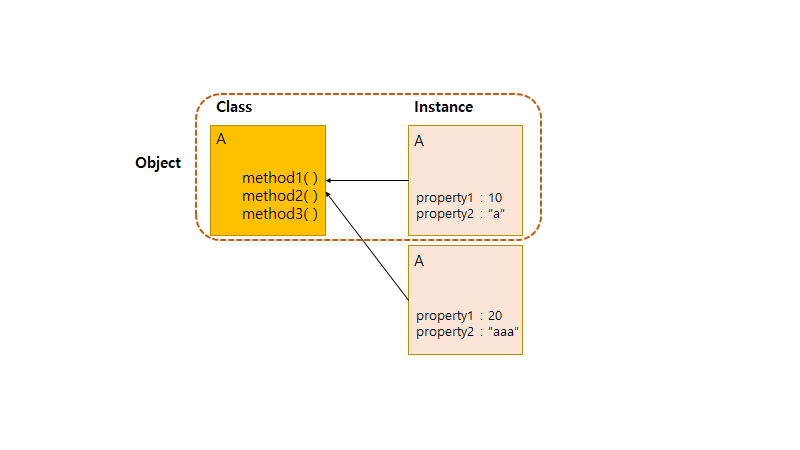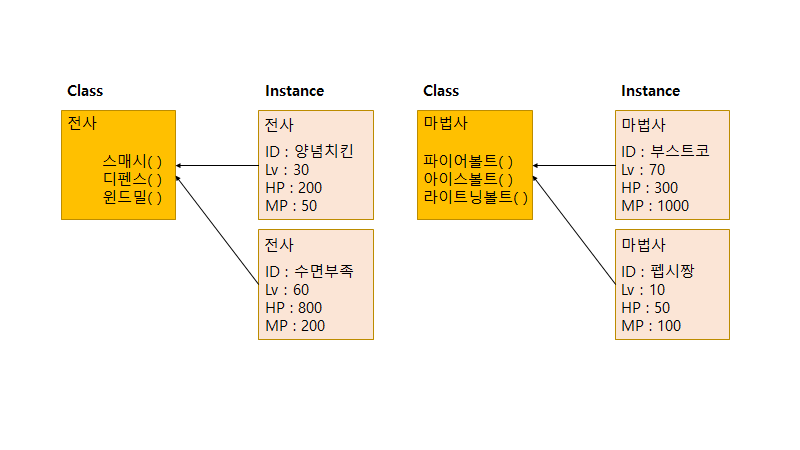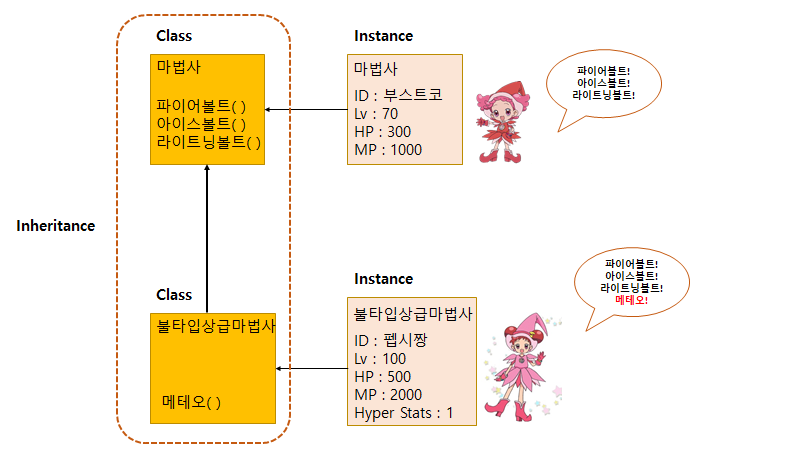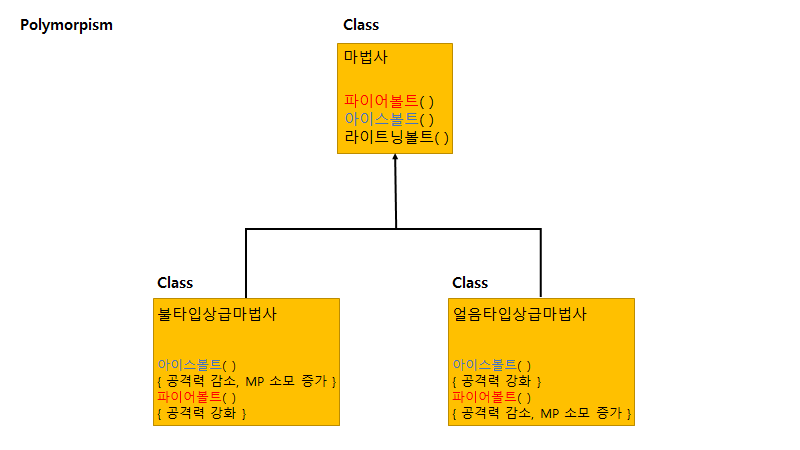2021.07.27 TIL (Today I Learned)
TIL (Today I Learned)
BoostCamp Challenge DAY-7
- Study OOP : Abstraction, Inheritance, Polymorphism
- Study SOLID Principles : SRP, LSP
- Study Javascript : enum
Study OOP (Object-Oriented Programming)
- 클래스 객체 class 와 객체 인스턴스 instance, object
- 프로퍼티 property 와 메소드 method
- 캡슐화 encapsulation
- 상속 inheritance
- 다형성 polymorphoism
- 객체 관계와 설계 패턴 design pattern
🧐 달달 외우고 있는 객체지향 4대 특징 (Encapsulation, Abstraction, Inheritance, and Polymorphism) 말고 진짜 OOP를 이해해야한다.
추상화(abstraction)
프로시저 추상화 (procedure abstraction) : 무엇을 해야하는지, 절차에 대한 추상화
- 간접 참조 (indirection) : 값 자체보다 컨테이너, 연결, 별명 등을 사용해서 우회해서 참조하는 방식
- 기능분해 (functional decomposition)
- 알고리즘 분해 (algorithm decomposition)
function makeGradeCard(name, scoreList) { //high level
let result = [];
result.name = name;
result.grade = getGrade(scoreList);
return result;
}
function getGrade(scoreList) { //low level
if(sum(scoreList) - getMax(scoreList) > 500) return "A";
return "B";
}
function sum(arr) { //more low level
let sum = 0;
for(let v of arr) sum += v;
return sum;
}
function getMax(arr) { //more low level
let max = -1;
for(let v of arr) max = max < v ? v : max;
return max;
}
추상화 레벨을 설명해보려고 작성한 예시이다.
성적표를 만드는 함수 makeGradeCard를 호출하는 사용자는 name(이름)과 scoreList(점수목록)만 input으로 입력하면 된다. 어떻게 성적을 알아내는지에 대해서는 알 필요가 없다.
sum(), getMax() - getGrade() - makeGradCard() 순서로 추상화레벨이 높아지는 것을 표현했다. sum() 함수는 getGrade() 함수보다 구체적이라고 할 수 있다. 반대로, getGrade() 함수는 sum() 함수보다 추상적이다.
- 프로시저 (procedure) vs 함수 (function)
- 과거에는 프로시저를 return 값 없이 절차만 기술하는 도구로써 함수와 용어적으로 구별하기도 했지만, 현대에는 큰 구별없이 사용되고 있다.
데이터 추상화 (data abstraction) : 무엇을 알아야하는지, 데이터에 대한 추상화
- 추상화(abstraction) : 복잡한 자료, 모듈, 시스템 등으로부터 핵심적인 개념 또는 기능을 간추려 내는 것을 말한다. (Wiki)
- 타입 추상화 : abstract data type (by 바바라리스코프)
- 타입 정의 선언
- 타입 인스턴스를 다루는 오퍼레이션 집합을 정의
- 제공하는 오퍼레이션으로 조작하도록 보호
- 타입에 대한 여러 인스턴스를 생성
- 데이터 중심 프로시저 추상화 : object-oriented (by 앨런케이)
- 상속과 다형성 지원
- 타입 추상화 : abstract data type (by 바바라리스코프)
🔎class vs. instance vs. object

A라는 class를 정의하면, A 타입의 instance를 여러개 만들 수 있다. 각 instance들은 고유한 property들을 가질 수 있고, class 에서 정의된 method들을 공유한다. method가 정의된 class와 각각의 property를 갖고 있는 instance를 합쳐서 object (객체) 라고 부른다.
class A { //class
int property1;
String property2;
void method1() {}
void method2() {}
void method3() {}
public A(int p1, String p2) {
super();
this.property1 = p1;
this.ptoperty2 = p2;
}
}
A a1 = new A(10, "a"); //instance
A a2 = new A(20, "aaa"); //instance
예시

Inheritance & Polymorpism
상속은 class A가 가진 method와 property들을 class A를 상속한 class B에 물려주는 것이다. class B는 class A가 물려준 것들 뿐만 아니라 class B에서 새로 정의한 method와 property도 사용할 수 있다.
다형성은 class A를 상속한 class B와 C에서 class A에서 상속해준 method를 각각 재정의(override) 하여 사용함으로써 method 이름은 같지만 상속받은 객체 B,C 각각의 특성에 맞는 method를 사용할 수 있게 해준다.
상속과 다형성을 잘 활용하면 객체의 재사용성을 높이고 추상도 높은 설계를 할 수 있다.
예시1


예시2
Parents class를 상속한 Child class에서 f1(), f2(), f3() 의 동작모습을 관찰한다.
class Parents {
constructor() {
this.data1 = 1;
this.data2 = 2;
}
f1 = () => console.log("I'm Parents - f()", this.data1, this.data2);
f2 = () => console.log("I'm Parents - g()");
f3() { //abstract method
throw new Error("must override f3 method");
}
}
class Child extends Parents {
constructor() {
super();
this.data1 = 100;
}
f1 = () => console.log("I'm Child - f1()", this.data1, this.data2);
f3 = () => console.log("I'm Child - f3()");
}
let arr = [];
let inf = new Parents();
let imp = new Child();
arr.push(inf);
arr.push(imp);
for (let obj of arr) {
console.log(obj instanceof Parents);//true
obj.f1();
obj.f2();
if (obj instanceof Child) obj.f3();
}
Study Javascript : enum
javascript는 enum type을 지원하지 않는다.
아래와 같은 방법으로 사용할 수 있다.
const Enum = Object.freeze({ A: 0, B: 1, C: 2, D: 3, E: 4, F: 5, G: 6, H: 7 });
f = function (str) {
let arr = [[10, 11], [12, 13]];
console.log(Enum[str]); //0
console.log(arr[Enum[str]]); //[10, 11]
}
console.log(Enum.C);//2
f("A");
typescript에서는 enum type을 지원한다. 다음에 사용해보자.
enum Enum {
A, // 0
B, // 1
C // 2
}
더 알아볼 것 - TypeScript enum을 사용하지 않는 게 좋은 이유를 Tree-shaking 관점에서 소개합니다.
😥 NOT DONE
- SOLID Principles
- S - Single-responsiblity Principle (SRP)
- O - Open-closed Principle
- L - Liskov Substitution Principle (LSP)
- I - Interface Segregation Principle
- D - Dependency Inversion Principle
-
SRP (Single-Responsibility Principle, 단일책임원칙)
- LSP (The Liskov Substitution Principle, 리스코프교환원칙)
3.3. Type Hierarchy
- 타입 계층은 서브 타입과 수퍼 타입으로 이루어진다.
- 하위 타입은 수퍼 타입의 모든 동작과 추가 기능을 이어받는다.
What is wanted here is something like the following substitution property [6]: If for each object o1 of type S there is an object o2 of type T such that for all programs P defined in terms of T, the behavior of P is unchanged when o1 is substituted for o2, then S is a subtype of T.
여기에 필요한 것은 다음과 같은 치환(substitution) 원칙이다. S 타입의 객체 o1 각각에 대응하는 T 타입 객체 o2가 있고, T 타입을 이용해서 정의한 모든 프로그램 P에서 o2의 자리에 o1을 치환하더라도 P의 행위가 변하지 않는다면, S는 T의 하위 타입이다.
Reference : https://johngrib.github.io/wiki/summary-Data-Abstraction-and-Hierarchy/
TIW (Today I Watched)
점점 밀린 공부거리가 쌓여가고 있다..🤪
공부를 DFS 방식으로 하는게 속이 편한데, 그러기엔 시간이 너무 부족하다.
https://www.youtube.com/watch?v=3smc7jbUPiE&ab_channel=Project%EC%8A%A4%EB%85%B8%EC%9A%B0%EB%B3%BC
부캠에서 추천해준 영상인데, 질문을 잘하는 법과 질문에 잘 대답하는 법에 대해 생각해볼 수 있는 영상이다.
Why 라는 질문을 할 때에는 내가 얼만큼 알고 있고, 어디까지 알고싶은지 잘 정의해야 한다.
Why 라는 질문에 대답할 때에는 상대방이 얼만큼 알고있고, 어디까지 대답해줄지에 대해 고민해봐야한다는 내용이다.
나는 스스로에게 질문하고 그 답을 찾는 과정(=공부)에 대해서도, 이 영상에서 말하듯이 파고들수록 “흥미롭지만” 일단은 (당장은 다음 질문에 대한 답을 찾기 위해) 세상의 요소로 받아들여야 할 것들은 인정하고 넘어가는게 시간 관계상 필요한 것 같다…
하지만 적어뒀다가 다음에 꼭 다시 확인해봐야겠다.
Reference
- https://velog.io/@feelslikemmmm/JavaScriptClass
- https://mylife365.tistory.com/281
- https://www.digitalocean.com/community/conceptual_articles/s-o-l-i-d-the-first-five-principles-of-object-oriented-design
- https://www.semanticscholar.org/paper/Data-Abstraction-and-Hierarchy-Liskov/36bebabeb72287ad9490e1ebab84e7225ad6a9e5?p2df
- https://blog.ndepend.com/solid-design-the-liskov-substitution-principle/